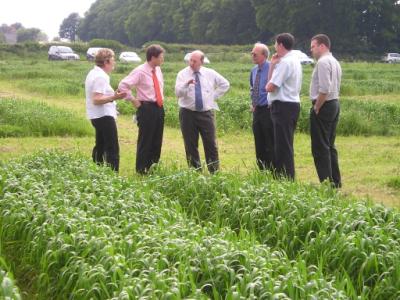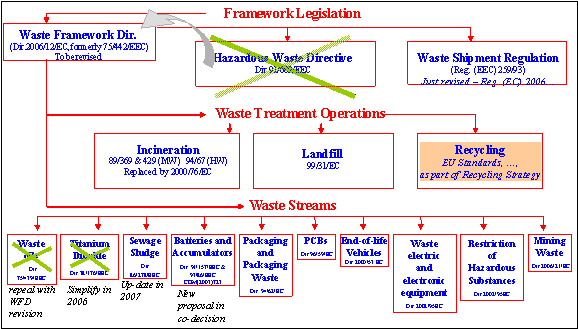
WASTEWATER RESEARCH AND INDUSTRY SUPPORT FORUM
Meeting 8th June 2006
Please note that for older reports some links will be to sites that are no longer active.
This was the Forum’s 30th meeting; it was held at FWR’s offices in Marlow. We were especially please to welcome Professor Helmut Maurer from the European Commission. Indeed, for the first time, all three of our speakers were professors.
Prof. Maurer described the work of Unit G.4, Sustainable Production & Consumption, at DG Environment and his portfolio of work, which includes the Landfill Directive, the Waste Shipment Regulation (Basel Convention) and the Sludge Directive. Helmut was uncertain about the proposal to revise the sludge directive because it is work well whereas there are many problems with the other two areas.

The cost of implementing EU waste legislation is high for acceding states; the Landfill Directive (LFD) will cost Turkey euros 9 billion out of a total of 75 bn for al environmental legislation. However, existing Member States are not is a good shape either: there are Infringement procedures concerning illegal /uncontrolled landfills against Greece, Italy and France and possibly also Spain. But, the whole system is flawed. The European Court has fined Greece euros 20k/day until adequate progress is made, this has so far totalled euros 4-5 million. The main objectives of the LFD are to prevent or reduce negative effects from landfilling on human health and the environment including climate change.
The EU-25 average for total municipal waste going to landfills is 49% but in some MS it is 90%. Although waste generation is growing parallel with the growth in GDP, the amount of waste that is being landfilled is slightly down. However the state of the landfills is cause for concern: in the EU-15 there are 504 hazardous waste landfills but only 141 comply (28%); there are 6286 non-hazardous waste landfills but only 1267 comply (20%) and there are 3416 inert waste landfills of which only 925 comply (27%). This is not even a complete picture because there are no figures from UK, Denmark or the Czech Republic on compliance. Since the LFD was implemented the number of permitted landfills has declined (i.e. site have closed) the quantity of waste, including biodegradable has declined and landfills have improved technically, but there is much more to do.
The targets [Art 5(2)] for reducing the quantity of biodegradable waste going to landfill referenced to the quantity in 1995 are: 75% by 2006; 50% by 2009 and 35% by 2016 (the UK has a 4 year derogation). AT, BE, DE, DK, NL and SE have already reached the 2016 target. FI, FR, and IT have reached the 2009 target or are close to it. EL, ES, IE and PT have reached the 2006 target. The UK is second worst after Greece. [The National Audit Office has picked up on this risk to the UK http://www.guardian.co.uk/g2/story/0..1839423.00.html].
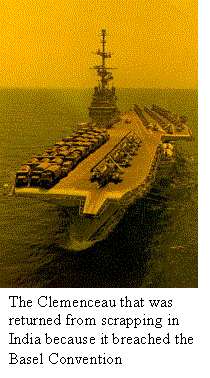 The Basel Convention is very political. Its objectives are that waste should be disposed where it is generated, the trans-boundary movement should be reduced to a minimum and controls should be applied stringently. The export of hazardous waste from non OECD countries is banned. There are rules on liability and compensation but they have not entered into force yet.
The Basel Convention is very political. Its objectives are that waste should be disposed where it is generated, the trans-boundary movement should be reduced to a minimum and controls should be applied stringently. The export of hazardous waste from non OECD countries is banned. There are rules on liability and compensation but they have not entered into force yet.
Regarding waste legislation in general, Helmut thought that we concentrate too much on treatment and disposal and not enough on prevention and recycling.
The European systems takes petitions very seriously, the Parliament has a Petitions Committee and the Commission also devotes time and resources to any petitions that it receives.
Helmut said the idea of producing a proposal for a revised sludge directive in 2007 is not possible because all of the work that would be involved. He also thought sludge should be in the soil framework rather than waste: a good case for this was made by the expert working groups on soil protection.
Prof. Richard Ashley in a tour de force presented three major pieces of work with which he and colleagues at the Pennine Water Group based at the University of Sheffield have been involved.
21st Century Sewerage was an UKWIR project, its objective was to examine the future of sewerage systems by setting out a vision for UK sewerage up until 2080 including both developments of an immediate nature and those that are more futuristic. It used the DPSIR (Driving forces, Pressures, States, Impacts, Responses) framework to analyse four socio-economic scenarios each of which would have a different climate change impact. The scenarios were called ‘world markets’, ‘national enterprise’, ‘local stewardship’ and ‘global sustainability’.
Now and up until 2020 the ranking of priorities was seen as: 1. Environmental Legislation; 2. Energy and Resource Use; 3. Climate Change; 4. Science and Technology; 5. Land Use and 6. Asset Condition. However looking out to 2080 the ranking changes to 1. Climate Change; 2. Environmental Legislation; 3. Land Use; 4. Energy and Resource Use; 5. Science and Technology; 6. Asset Condition.
Legislation has changed the emphasis from public health to the environment. The WFD could eliminate all CSOs, but the cost will be huge. We have not really started to do anything differently yet and many assets constructed in the last 25 years already need replacement. The Media are misrepresenting the performance of sewer systems; the answer to this is in the hands of the water industry to communicate more and better. The asset life of sewer systems is long so we should guard against lock-in to the wrong technology, but there is not much sign of that yet.
The project also looked at what other countries are doing. The Netherlands has decided all combined sewers have to be separated. If sanitary sewers only carry sanitary flow the volume is pretty constant, apart from infiltration. If surface water drains overflow the consequences are less than when surface water is combined with sanitary drainage. The city of Alkmaar (population 94,000) is located in a typical Dutch polder landscape, close to a major nature reserve with dunes, beach, woods and water, water everywhere. It saved 80M euros by separating the combined sewers compared with building/upgrading CSO chambers. Stormwater uncontaminated by sanitary sewage might even be a resource.
Germany, Austria and France are using Real Time Control extensively and innovative stormwater systems.
 In the USA many combined sewers have been separated so as to comply with the Clean Water Act (CWA) National Pollution Discharge Elimination System (NPDES) permit program and Total Maximum Daily Load Program (TMDL) regulations even in major cities like Boston. Charges are based on the area of impervious surface connected to the sewer. An example of SUDS from Seattle shows new approaches can save money: a 100m street was taking the drainage of 10ha the use of infiltrating soils, vegetated swales and planting tres and shrubs cost US$285k compared with $520k for no infiltration and underground storage chambers.
In the USA many combined sewers have been separated so as to comply with the Clean Water Act (CWA) National Pollution Discharge Elimination System (NPDES) permit program and Total Maximum Daily Load Program (TMDL) regulations even in major cities like Boston. Charges are based on the area of impervious surface connected to the sewer. An example of SUDS from Seattle shows new approaches can save money: a 100m street was taking the drainage of 10ha the use of infiltrating soils, vegetated swales and planting tres and shrubs cost US$285k compared with $520k for no infiltration and underground storage chambers.
There is an inexorable move towards integrated management of all aspects of the water cycle and a drive for sustainable communities (and services) but are EU directives incompatible with these objectives? A number of barriers and constraints are militating against introducing an integrated sustainable approach, particularly the existing governance, regulatory and institutional arrangements. The UKWIR report concluded that the water industry is unlikely to be able to influence customer behaviour. Environmental regulation will probably further restrict discharges. The EA seems view environmental protection as watercourse preservation, rather than whole system sustainability. Ofwat should give more consideration to the other 2 legs of sustainability instead of focussing exclusively on cost. We also need to be more serious about climate change in sewer construction, these are very long lived assets and yet UKCIP is not brought into planning.
Richard commented on the far-reaching effects of the Water Framework Directive, which could end discharges to water bodies, prohibit a number of substances through its daughter directive on dangerous substances and cost the UK alone £6bn. The additional treatment could have massive energy and climate change impacts. Of course, withdrawal from the EU could result in more proportionate regulation.
We need to investment in the proper maintenance and serviceability, which have not been given appropriate priority in the AMP process. Curtailing ‘man-entry’ into sewers will entail using and developing remote entry and robotic techniques. We shall need to improve understanding of system performance in order to demonstrate compliance and auditable value for money. This, in turn, will require better models and people better trained n their use. We should not be blind to new technologies from other sectors. Energy recovery and better management of residuals are essential. There needs to be much stronger public engagement than at present for optioneering, understanding of what is being done and buy-in to solutions.
We cannot continue as we are because the drivers are too strong [albeit they are uncertain]. Much of the technology and ideas we need are already developed. To be effective, robust and resilient we need adaptable, complex and integrated responses that at their heart include institutional and governance realignment and stakeholder engagement. We should not ‘lock-in’ to regrettable options that are not adaptable.
In a telling and memorable remark Richard said “I started as a public health engineer, and since then we have spent billions of pounds on the water environment, it is now environmental engineering, and I can’t get a National Health dentist. Have we got the balance quite right?”
The OECD International Futures Project on Global Infrastructure Needs, water was added as an afterthought! It looks out to 20301. Its purpose, to establish a fuller picture of the likely impacts of key social, economic, environmental, technological and political trends on long-term future demand for, and investment in water infrastructure in OECD countries and some or all of the Big 5 economies, with a view to providing a suitably forward-looking framework for subsequent discussion on the future viability of current business models. In essence the scenario proposed by OECD was the UKWIR ‘world markets’. Water has moved up the OECD’s agenda now they appreciate the amount of money involved.
The environment in which infrastructure development will take place will be much more complex and difficult because the decision making process will involve more actors (including non-state) and the range of issues to be addressed is broader. Financing will be more difficult because the fiscal positions of governments are likely to be tighter (large social expenditures and eroding tax bases). The risks are likely to rise because of natural hazards and from human action. But, the pressure to develop infrastructure will be greater than ever as society becomes increasingly dependent on a growing range of infrastructure services. Demography, notably in the developing world, will create high pressure for basic infrastructure development. Security concerns will call for significant upgrading of infrastructure to enhance the robustness and resilience. Strategic concerns will motivate development of infrastructure designed to reduce international dependence by increasing the diversity of supply.
Domestic demand will increase the fastest – accounting for 21% of global demand in 2025, whereas industrial demand will decrease in developed countries and agricultural demand will decrease from the current 75% to 56% in 2025. The OECD countries are relatively stable business models and full cost recovery and affordability will enable industry to stand on its own feet with good availability of financing. For the Transition Economies, affordability and revenue generation are matters of concern, the institutional & regulatory capacity needs strengthening and there are structural constraints on investment in services. In the case of Developing Countries there will be dependence on emergence of partnership arrangements as vehicles of transfer from developed to developing countries; India and China will be well placed to overcome the difficulties but Africa and the Middle East may not be quite so fortunate. The report says the total annual investment for the 34 countries studied is currently US$576.4bn and predicts US$772.1bn in 2015 and US$1037.8bn in 2025 – a doubling in annual investment in 20 years.
Richard was technical advisor to the House of Lords’ Water Management Inquiry; the report and Minutes of Evidence can be downloaded at http://www.publications.parliament.uk/pa/ld/ldsctech.htm. Its purpose was to investigate the future management of water in England and Wales in the context of demographic and economic development, and, in the longer term, of climate change. What are the causes of the current problems of water supply, and how serious are they? What are the projections for future water supply, and what factors will influence these projections? Where, and over what timescales, may problems emerge? Is sufficient research being devoted to predicting, and handling, possible future scenarios? Is the response of the UK Government, the EU, regulators and the industry adequate? The inquiry was very searching and came up with many valuable recommendations:
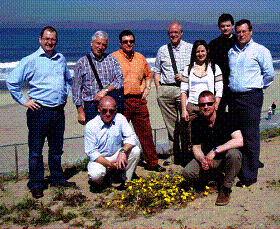 Finally Richard reported on the DTI SUDS Global Watch Mission to the USA that he organised in March 2006. 13 States in 12 days and 30 conclusions per day. You can download the report from http://www.oti.globalwatchonline.com but you have to register (free of charge) first.
Finally Richard reported on the DTI SUDS Global Watch Mission to the USA that he organised in March 2006. 13 States in 12 days and 30 conclusions per day. You can download the report from http://www.oti.globalwatchonline.com but you have to register (free of charge) first.
The purpose and objectives were to examine the regulations, management and technologies used in the USA to control surface water flow, associated pollution and treatment to minimise environmental impact. To review how the methods to control run-off and water flow minimize the potential for adverse effects on properties, people and the receiving waters in the environment and the potential for SUDS solutions to provide amenity benefits within developments. To review the contribution and relative cost-benefits of SUDS to management and maintenance of adequate useable water resources. It was demanding, rewarding, hugely beneficial in terms of fact finding and eye opening; the mission learnt ![]() from US successes and best practice and also learnt from US failures and mistakes. The Clean Water Act in the USA and the Water Framework Directive in the UK are the main drivers, they address the perceived need to clean up the environment. In the US the focus is on quality whereas in England and Wales it is quantity (at moment). In the USA, flooding and climate change are not as significant drivers as in the UK. The threat of (and actual) prosecution is a strong US driver, also the nature and use of the receiving water body.
from US successes and best practice and also learnt from US failures and mistakes. The Clean Water Act in the USA and the Water Framework Directive in the UK are the main drivers, they address the perceived need to clean up the environment. In the US the focus is on quality whereas in England and Wales it is quantity (at moment). In the USA, flooding and climate change are not as significant drivers as in the UK. The threat of (and actual) prosecution is a strong US driver, also the nature and use of the receiving water body.
The CWA makes clear recommendations about education and community participation. There is a need to build capacity within the stakeholder communities to help them understand/accept innovative approaches and technologies.
There are a number of excellent examples in the USA, including publications and programmes offered by the Center for Watershed Protection http://www.cwp.org/. Engagement is the key to gaining momentum and support - needs to be clear and concise and at an appropriate level to each stakeholder community. Perhaps it is the geography or the nature of politics but the US seems better able to do this than us.
The US regulatory framework [CWA-NPDES-TMDL] results in a locally devolved, flexible approach to the management of stormwater appropriate to the local context and region. Contrast this with the WFD.
For the UK we need to understand the effectiveness of dispersed solutions for managing of stormwater in the UK context better. This includes considering the costs, risks and institutional barriers within a whole system performance context. The cross-regulatory and institutional barriers from the mixed management responsibility for stormwater in England and Wales need to be exposed and eliminated. There is a good case for establishing separate stormwater utilities in the UK and specialist SUDS inspectors. Such utilities may be attractive to existing sewerage undertakers if SUDS can be defined as assets.
There is a strong case for a single stormwater agency to facilitate SUDS adoption and having responsibilities for flood risk management. Any agency in this role should not be constrained by the need to maintain and own assets, but rather to be able to operate across the whole range of structural and non-structural approaches to stormwater management, supporting other stakeholders where appropriate.
Regarding funding there could be a separate stormwater charge on property owners based on roof/impervious area), Local/Highway Authorities should pay for their stormwater, developers should they pay a bond up front which they forfeit if they fail to construct their SUDS properly.
Because of WFD, diffuse pollution from stormwater is going to have a major impact and is probably not deliverable (e.g. 100%ile on cadmium and nickel). We need to influence the legislators now (not wait until 2009 when it will be too late). It has taken the USA 30 years to implement the CWA. Most of which is litigation driven; the WFD was always unrealistic in expecting us to do it in less than 10. US experts have an alternative definition for the acronym TMDL (Total Mean Daily Load) Too Many Damn Lawyers.
If we sort out the funding then maintenance is an opportunity to manage the risk not a headache. If the SUDS are assets then they increase the company worth, responsibility for them could be delegated to “enlightened authorities” using Model Agreements. We should learn from mistakes and always move forwards! In E&W SUDS has focused predominantly on quantity; in the USA quality is a major issue because of the CWA; the WFD will have a similar effect here so we need to be prepared for that.
 Prof. Brian Chambers of ADAS described the long-term field trials that have been established to improve the robustness of scientific information for setting soil metal limits in connection with use of sewage sludge on land, especially regarding impacts on soil microbial activity as well as on crops and soil chemical and physical properties. There are 9 sites covering different climates and soil types. This is almost certainly the most extensive field experiment on this subject running anywhere in the world.
Prof. Brian Chambers of ADAS described the long-term field trials that have been established to improve the robustness of scientific information for setting soil metal limits in connection with use of sewage sludge on land, especially regarding impacts on soil microbial activity as well as on crops and soil chemical and physical properties. There are 9 sites covering different climates and soil types. This is almost certainly the most extensive field experiment on this subject running anywhere in the world.
The sites were established over 4 years (1994-1997) to achieve a range of concentrations of soil copper, zinc and cadmium using old sludges that pre-dated effective source control and had exceptionally high concentrations of these elements that are never seen in today’s sludges. Modern sludges were used to balance up the organic matter contents. As an unrealistic worst case, metal salts were added to some plots. An inevitable limitation of the design is that in order to build up the soil concentrations to 150% of the ceiling limits in the current regulations, the applications were in breach of those regulations and would have overloaded the soils’ sorption capacities. Also as far as bacteria are concerned, a lump of sludge can be their whole environment (i.e. 6000 mgZn/kgDS) rather than the concentration averaged through the topsoil.
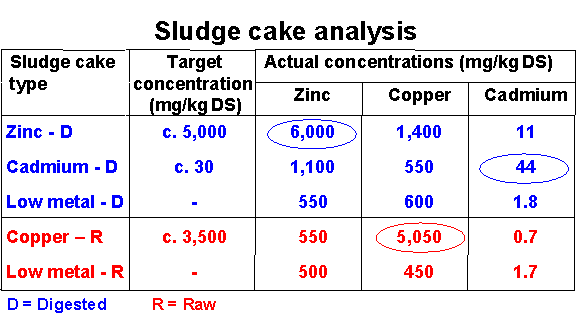
The trial measures soil microbial biomass carbon, which is a measure of the total soil microbial population (i.e. bacteria, fungi, actinomycetes, etc.), the respiration rate, which is a measure of soil microbial activity and the numbers of Rhizobia these are bacteria of notable agricultural significance because they fix nitrogen.
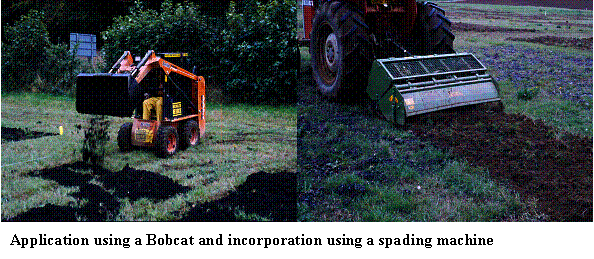
The conclusions for Phase II (1998-2002) are that the Rhizobia responses were most pronounced at three of the sites 1999 and 2001on their Zn sludge cake plots but no response was seen on the liquid sludge or metal salt plots, which is counter intuitive. The biomass responses were greatest on the Cu treatments in all three experiments. Considering yields and quality of the cereal crops, there has really been no significant effect on yield except for Cu sludge cake at one of the nine sites. There might be a link between grain Cd concentration and total soil Cd and pH. The results from Phase III (2002-2006) are still being processed but the preliminary indications are that they show the soils are not yet fully ‘equilibrated’, the added organic matter is still being ameliorated, the soil pH is still changing and further mixing is needed.
In the afternoon some participants visited one of the field trial sites at Watlington, Oxfordshire.
